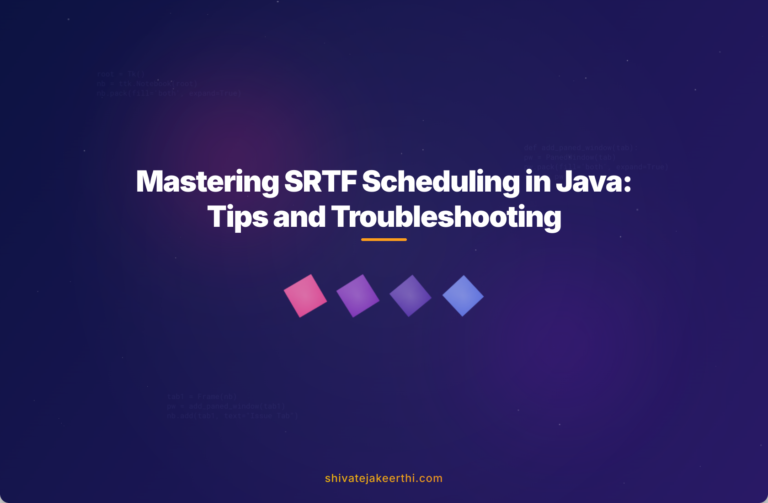Working with operating systems often requires careful attention to how processes are scheduled. Getting the chance to implement scheduling algorithms yourself, like the Shortest Remaining Time First (SRTF), can help solidify your understanding of how an OS manages multiple tasks efficiently. But what do you do when your Java implementation of the SRTF scheduling algorithm doesn’t behave correctly?
Let’s start by clearly understanding what SRTF actually is. Simply put, the Shortest Remaining Time First (SRTF) scheduling algorithm is a type of preemptive scheduling that always runs the process with the shortest remaining execution time. This is an advancement over non-preemptive algorithms such as Shortest Job First (SJF), where once a process starts, it cannot be interrupted.
Imagine you’re in line at a grocery store. Normally, the cashier helps customers in the order they arrive. But what if the cashier always picks the shopper with the fewest items left to scan? Even if someone has already started checking out, a new arrival with fewer items can temporarily stop their checkout. Similarly, SRTF pauses running processes to prioritize ones that complete the quickest.
Key features that make SRTF popular include:
- Minimizing average waiting time compared to other methods.
- Ensuring high CPU utilization.
- Allowing urgent shorter processes to get quicker access to resources.
Now, let’s talk about how you can set up the structure of your SRTF scheduling algorithm in Java effectively.
Building the Scheduler in Java
To implement SRTF scheduling, start by creating two primary classes: Scheduler and Process.
The Scheduler Class Structure
The Scheduler class will manage and execute all your processes. It should clearly handle initialization, execution, and result output.
Here’s how your basic Scheduler class might look:
public class Scheduler {
List<Process> processes;
int currentTime;
public Scheduler(List<Process> processes) {
this.processes = processes;
this.currentTime = 0;
}
public void run() {
// Scheduling logic
}
private Process getShortestRemainingTimeProcess() {
// logic to find the shortest remaining time process
}
public void printResults() {
// Output results clearly
}
}
The Process Class Structure
Your Process class stores individual process details like arrival time, burst time, remaining time, and completion metrics.
public class Process {
int processId;
int arrivalTime;
int burstTime;
int remainingTime;
int completionTime;
int waitingTime;
int turnaroundTime;
public Process(int processId, int arrivalTime, int burstTime) {
this.processId = processId;
this.arrivalTime = arrivalTime;
this.burstTime = burstTime;
this.remainingTime = burstTime;
}
}
You can initialize your process objects by constructing a list in your main program or test harness.
Debugging and Fixing Issues in Your SRTF Implementation
You’ve set everything up, but what if your output isn’t matching the expected results? Imagine you expected:
- Average waiting time: 3ms
- Average turnaround time: 7ms
But your implementation instead produces significantly different values. Let’s figure out why.
First, verify your algorithm behaves preemptively. If your implementation looks more like a non-interruptible SJF, fix it by allowing running processes to pause if a new one with a shorter remaining time arrives.
Second, ensure that context switches happen correctly. Improper context switching can skew your metrics significantly.
Here’s how to debug your “run” method to correctly implement preemption:
public void run() {
int completedProcesses = 0;
Process currentProcess = null;
while (completedProcesses < processes.size()) {
Process nextProcess = getShortestRemainingTimeProcess();
if (nextProcess == null) {
currentTime++;
continue;
}
if (currentProcess != nextProcess) {
currentProcess = nextProcess; // Correctly switch the context to shortest remaining time
}
// Run the selected process
currentProcess.remainingTime--;
currentTime++;
if (currentProcess.remainingTime == 0) {
currentProcess.completionTime = currentTime;
currentProcess.turnaroundTime = currentProcess.completionTime - currentProcess.arrivalTime;
currentProcess.waitingTime = currentProcess.turnaroundTime - currentProcess.burstTime;
completedProcesses++;
}
}
}
Crucially, make sure your getShortestRemainingTimeProcess() correctly identifies the active process with the smallest remaining burst time:
private Process getShortestRemainingTimeProcess() {
Process shortestProcess = null;
int shortestTime = Integer.MAX_VALUE;
for (Process p : processes) {
if (p.arrivalTime <= currentTime && p.remainingTime > 0 && p.remainingTime < shortestTime) {
shortestProcess = p;
shortestTime = p.remainingTime;
}
}
return shortestProcess;
}
Testing Your Fixed Implementation
After implementing these fixes, test thoroughly. Input known test cases from reputable sources, such as textbook scenarios or well-documented Stack Overflow examples (check out this scheduling resource on Stack Overflow).
Compute standard performance metrics like:
- Average Turnaround Time: Measure an individual process’s completion time minus its arrival time, then average across all processes.
- Average Waiting Time: Time each process spends waiting in the ready queue, averaged.
- CPU Utilization: Measure how effectively your algorithm uses CPU resources without idle or wasted cycles.
Here’s a quick table format to summarize process outputs:
| Process ID | Arrival Time | Burst Time | Completion Time | Waiting Time | Turnaround Time |
| 1 | 0 | 7 | 16 | 9 | 16 |
| 2 | 2 | 4 | 6 | 0 | 4 |
Adjust your test data and verify if the calculated metrics match your expectation.
Whether you’re coding for fun, classwork, or an actual OS module, getting your SRTF implementation right is crucial. A properly working code shows not only correct outputs but also deepens your understanding of scheduling methods used in operating systems.
Once completed, consider exploring related JavaScript concepts on this JavaScript category page; understanding event-driven programming models in JavaScript might give you more perspective on scheduling methods and application responsiveness.
Have you successfully debugged your SRTF implementation now? What was the trickiest bug you’ve encountered in your scheduling algorithms? Feel free to share your experiences or questions!



0 Comments